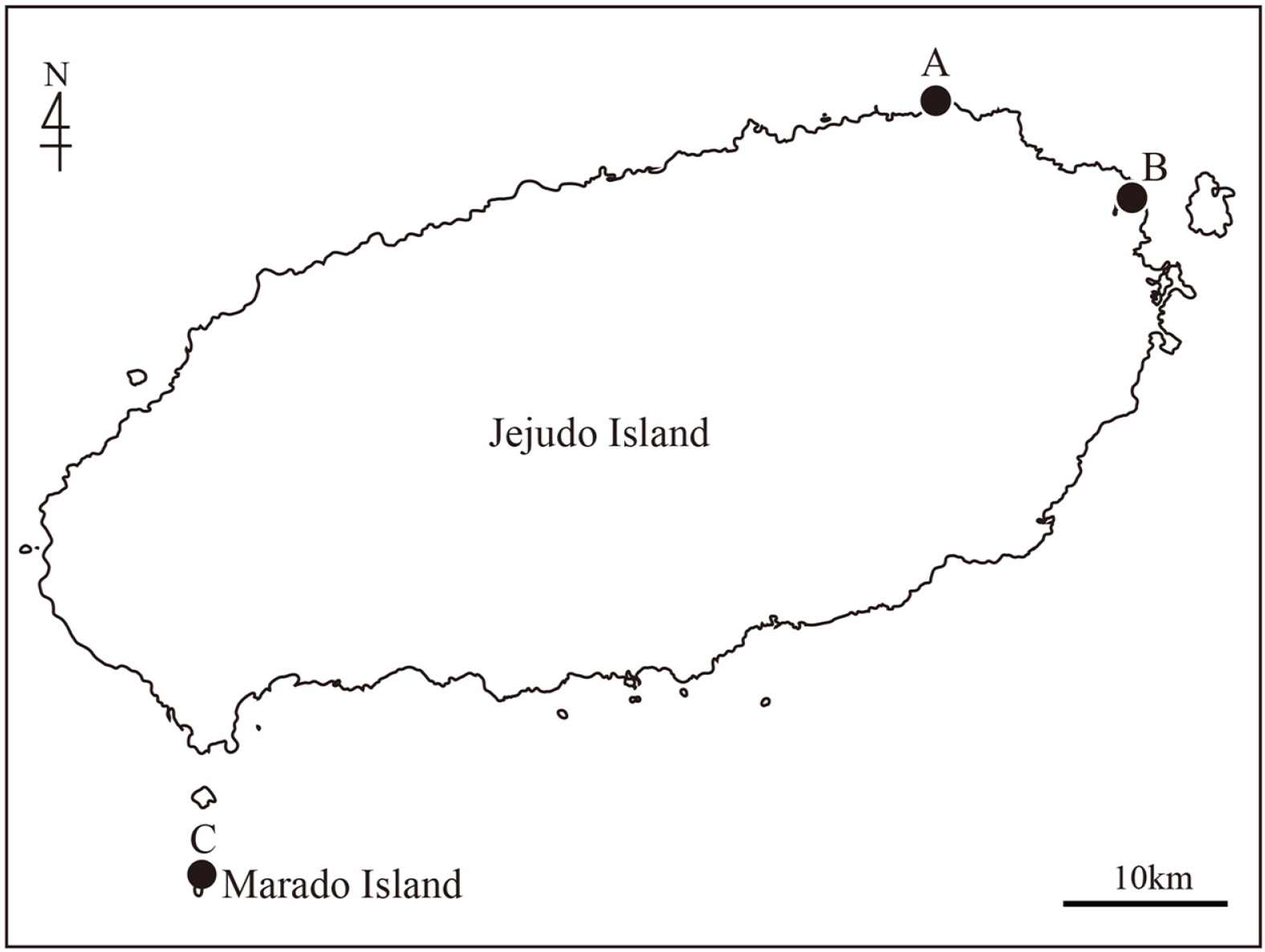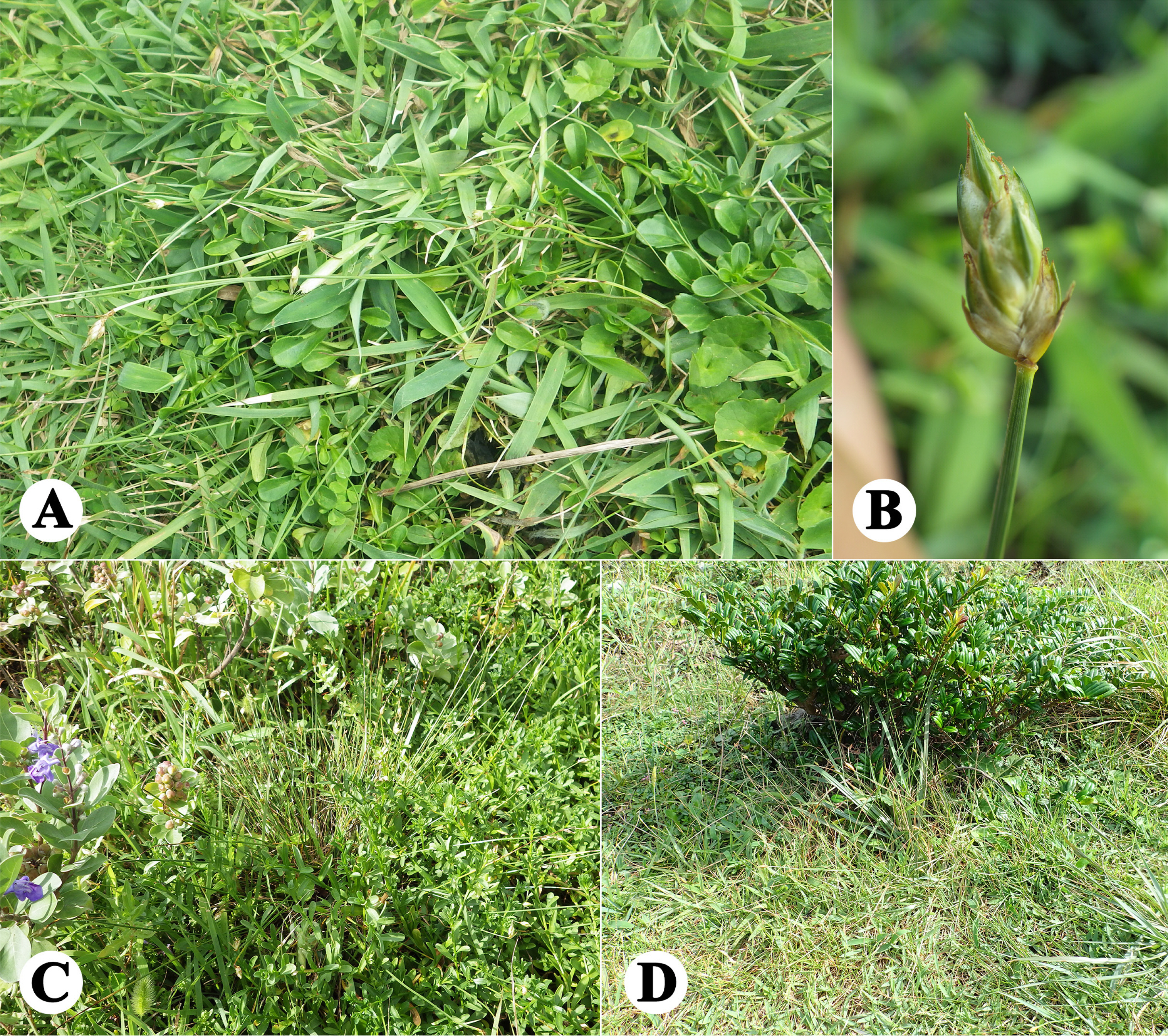Record of Fimbristylis ovata (Cyperaceae) from Jejudo Island, Korea
Article information
Abstract
We report Fimbristylis ovata (Burm.f.) J. Kern (Cyperaceae) from the sunny grasslands along the coastline on Jejudo Island, Korea, as a new distribution in Korea. This is thought to be the third confirmed record of this rare sedge in Korea; the first was from Gapari (‘Is. Quelpaert’) collected by Taquet in 1908, and the second was from Marado Island, collected by Kim and Kim in 2018. We found two new populations on Jejudo Island, the first with many individuals and the second with only a few plants. Following an examination of herbarium specimens, this species is considered to be rare and endangered in Korea, limited in distribution in Korea to Jejudo and Marado Islands.
Fimbristylis ovata (Burm.f.) J. Kern (often treated as a synonym of F. monostachyos (L.) Haask. or Abildgaardia ovata (Burm.f.) Kral) (Cyperaceae) is a perennial herb which mainly grows in sunny coastal grasslands in the tropics and subtropics (Govaerts et al., 2007; Hoshino et al., 2011).
In Korea, Nakai (1914) reported this species as growing in grasslands on Jeju Island, based on a specimen in the herbarium of University of Tokyo (TI). Ohwi (1944) also cited a specimen of this species from Jeju Island in Kyoto University herbarium (KYO) (Ins. Quelpaert: E. Taquet no. 2081). Since then, this species is only mentioned from Korea in publications by Lee (1980) and Oh (2007). Lee (1980) gave an illustrated account of the morphological features, whilst Oh (2007) included the name in a species list, noting “Lee (1980) reported the occurrence of F. monostachya in Korea, but I have not seen any specimens of it.” Therefore, the distribution of this species in Korea has been uncertain because specimens from Korea could not be confirmed. Recently, Kim and Kim (2018) discovered F. ovata growing in the grasslands on Marado Island, located to the south of Jeju Island, the most southern part of Korea. However, the distribution of this species from other localities in Korea was still uncertain.
During a field expedition in 2019, we found F. ovata from two localities in Jejudo Island, and the north side in Marado Island (Fig. 1). In Jejudo Island this species was found growing in sunny grasslands along the northern and eastern coast in Gujwa-eup, Jeju-si (Figs. 1, 2). Many individuals were found in one population A on the northern coast (Fig. 1A), but for the other population B on the eastern coast few plants were seen (Fig. 1B). In population A of the northern coast, this species grew with coastal plants; e.g., F. ferruginea (L.) Vahl var. sieboldii (Miq. ex Franch. et Sav.) Ohwi, Setaria viridis (L.) P. Beauv. var. pachystachys (Franch. et Sav.) Makino et Nemoto (Poaceae), Sedum japonicum Siebold ex Miq. subsp. oryzifolium (Makino) H. Ohba var. oryzifolium (Makino) H. Ohba (Crassulaceae), Hibiscus hamabo Siebold et Zucc. (Malvaceae), Vitex rotundifolia L.f. (Lamiaceae), Aster hispidus Thunb. (Astaraceae) (Figs. 1A, 2C). We also identified the following plants around population A; Vitis ficifolia Bunge var. sinuata (Regel) H. Hara (Vitaceae), Lotus corniculatus L. var. japonicus Regel, Rhynchosia volubilis Lour., Vigna angularis (Willd.) Ohwi et H. Ohashi var. nipponensis (Ohwi) Ohwi et H. Ohashi (Fabaceae), Plantago virginica L. (Plantaginaceae), Isodon inflexus (Thunb.) Kudô (Lamiaceae), and Artemisia capillaris Thunb. (Astaraceae). In population B of the eastern coast, this species grew with Poaceae (e.g., Zoysia japonica Steud., Z. pacifica (Goudswaard) M. Hotta et Kuroki, Ischaemum anthephoroides (Steud.) Miq., Setaria viridis var. pachystachys), A. hispidus, Centella asiatica (L.) Urb. (Apiaceae), and Eurya emarginata (Thunb.) Makino (Ternstroemiaceae) (Figs. 1B, 2A, D). We also identified the following plants around population B; Cyperus cyperoides (L.) Kuntze (Cyperaceae), Boehmeria pannosa Nakai et Satake (Urticaceae), Carpinus turczaninovii Hance (Betulaceae), Hedyotis biflora (L.) Lam. var. parvifolia Hook. et Arn. (Rubiaceae), P. virginica, and Cnidium japonicum Miq. (Apiaceae). In Marado Island, a lot of individuals were seen growing with F. ferruginea var. sieboldii, S. viridis var. pachystachys, S. japonicum subsp. oryzifolium var. oryzifolium, and Peucedanum japonicum Thunb. var. japonicum (Apiaceae) in the grasslands on the north side (Fig. 1C): the location previously reported by Kim and Kim (2018). Voucher specimens of F. ovata are kept in the Herbarium of the Okayama University of Science (OKAY) and the Korea National Arboretum herbarium (KH).

Distribution map of Fimbristylis ovata in Korea. A and B, Two populations of northern and eastern coast in Gujwa-eup, Jejusi, Jejudo Island, respectively; C, Marado Island.

Photograph of Fimbristylis ovata from Jejudo Island. A. Whole plants. B. Flowering spike. C. Habitat in population A of northern coast. D. Habitat in population B of eastern coast.
We also examined the herbarium specimen of this species in TI, KYO, KH, and the herbarium of the Korean National Institute of Biological Resources (KB). In TI and KYO, we found the specimens cited by Nakai (1914) and Ohwi (1944) respectively. These specimens are duplicates of the collection from Gapari (now Gapado Island and Marado Island) in Quelpaert by Taquet in 14 Sep 1908. No specimens of this species were found in KH and KB, confirming a previous report by Kim and Kim (2018). Therefore, this species is considered to be a rare and endangered plant in Korea, limited in distribution in Korea to Jejudo and Marado Islands.
Taxonomic Treatment
Fimbristylis ovata (Burm.f.) J. Kern, Blumea 15: 126, 1967 (Fig. 1); Carex ovata Burm.f., Fl. Indica, 194, 1768; Abildgaardia ovata (Burm. f.) Kral, Sida 4: 77, 1971.—TYPE: INDONESIA. Java, Burman s.n. (lectotype: G).
Cyperus monostachyos L., Mant. Pl. Altera ii: 180, 1771; Abildgaardia monostachyos (L.) Vahl, Enum. Pl. 2: 296, 1805; Fimbristylis monostachya (L.) Hassk., Pl. Jav. Rar.: 61, 1848; Iria monostachyos (L.) Kuntze, Revis. Gen. Pl. 2: 751, 1891.—TYPE: INDIA. Koenig s.n. (lectotype: LINN 70.3).
Description (mainly based on Korean material): Herbs, perennial. Rhizomes short. Culms 15–40 cm tall, longer than leaves. Basal sheaths brown. Leaves blade 0.5–1 mm wide, apex acute. Bracts shorter than spike. Inflorescences reduced to a single or rarely two terminal spikelets. Spikelets lanceovoid, 7–15 mm long, slightly compressed. Glumes yellowish green, broadly ovate to ovate, distichous, 3–6 mm, leathery, shiny, abaxially 3-veined, with short awns. Achenes obovoid, 2.5–3 mm long, yellowish white, smooth or small tubercles on surface. Styles slightly broad at base, margins spinulated. Stigmas 3.
Habitats: Sunny coastal grasslands.
Phenology: Flowering Jul–Oct.
Distribution: Korea (Jejudo Island and Marado Island); (Tropical Africa, W Asia, S Asia, E Asia [China, Japan, Korea], SE Asia, Oceania, Pacific islands, C America, S America). The photograph of detail morphology of this species from Korea (see Kim and Kim, 2018).
Specimens examined: KOREA. Jeju-do. Quelpaert in herbidis Gapari, 14 Sep 1908, E. Taquet no. 2081 (KYO!, TI–00017432!); Seogwipo-si, Marado Island, 17 Aug 2017, J. H. Kim nos. 174384, 174386, 174393 (JNU - not seen); Jeju-si, Gujwa-eup, 7 Sep 2019, O. Yano, Y. Tamura, Y. Yamaji, K.-S. Chung, H.-T. Im nos. 19090703-19090714 (OKAY!); Jeju-si, Gujwa-eup, 7 Sep 2019, K.-S. Chung, O. Yano, Y. Tamura, Y. Yamaji, H.-T. Im no. 6311 (KH!).
Note: on a label of this specimen in TI, “Quelpaert in herbidis Totori” handwritten by T. Nakai, is probably due to a mistake in copying “Gapari”.
Key to Fimbristylis ovata from other Fimbristylis taxa in Korea
Spikelets slightly compressed; glumes distichous arranged ·· ················································································ F. ovata
1. Spikelets not compressed; glumes spirally arranged ······· ········································· other Korean Fimbristylis taxa
Acknowledgements
We thank Dr. Mark F Watson, Royal Botanic Garden Edinburgh, for his help in checking the English of the manuscript. We also thank Dr. Hiroshi Ikeda, University Museum, University of Tokyo (TI), and Dr. Hidetoshi Nagamasu, Kyoto University Museum (KYO), for access to specimens. The staff members, Chang Woo Hyun and Soeun Jeong at Korea National Institute of Biological Resources herbarium (KB) and Dr. Dong Chan Son at Korea National Arboretum herbarium (KH), helped with specimen examinations.
Notes
Conflict of Interest
The authors declare that there are no conflicts of interest.
